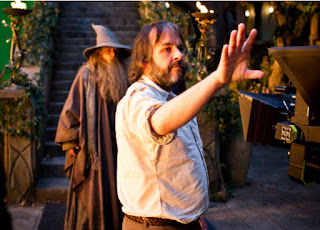Because I'm someone who likes to occasionally ramble about things I'm passionate about even though I lack the expertise to do so, I feel like I need to weigh in on all this 48fps/high frame rate/Hobbit commotion that's going on. I'll say from the outset I AM at a disadvantage because I haven't seen The Hobbit yet so can't comment with complete confidence about what exactly The Hobbit's high frame rate looks like to my own eyes. But I will just riff on a few things I've been reading on the web and discuss my general feeling(s) on the matter.
As you might have heard, Peter Jackson decided to shoot the Lord of the Rings prequel The Hobbit at a higher frame rate than normal. Films are usually show 24 frames per second, and you do have the option to see The Hobbit at 24fps at the movies, but Jackson's conscious aesthetic decision was to shoot 48fps (+ 3D). 48fps doesn't look like 24fps. Although it's been said that it works better for 3D, 48fps also makes everything look SUPER-real - hence less real in a movie-movie sense: sets look like stage props, prosthetic make-up looks rubbery and so on. This has been my biggest problem with digital filmmaking to date. But it's almost not a technical issue. You can argue for tech advancement, saving costs, etc. but is it possible to argue going against the nature of cinema itself?
Ok, let's put it in simpler terms: why this obsession with making cinema look as real as possible? The beauty of cinema is that magic layer that lies between us and the big screen. Many viewers have complained about the "super-real" look of The Hobbit taking them out of the action - is that Peter Jackson's intention? I realise it's all purely subjective, but I can't get my head around the fact that Jackson would want to destroy that layer of make-believe - that immersion in the cinematic experience - by producing images that look fake and plasticky. I don't really want to feel like Bilbo Baggins is standing in front of me in my living room (maybe some people do? I don't know), because I KNOW for a fact that he's not REAL. He doesn't exist. I want to suspend my disbelief and pretend he does. 48fps seems antithetical to this.
This tweet by movies.com editor Peter S. Hall kinda sums it up:
Unlike celluloid, digital hasn't had 100 years of fine-tuning to make it work "right" just yet. There are so many freaking variables at play to successfully achieve a perfectly rendered "other cinematic world". Middle Earth is a massive world. You need to envelop your viewers in it. The LOTR movies did this fine. And to envelop your viewers you don't really want to have a great-looking 3D action set-piece one minute and then have other scenes that look like they've just come from a '70s TV soap. It's pretty much the same issue with any film that wants to transport the viewer into another time and place.
Michael Mann's Public Enemies is a prime example of a period film that never felt convincing because of its digital video look. It looks like it was shot by someone with an expensive handy-cam and some good tailoring at their disposal. It doesn't look or feel like the Depression. If you want a Depression-era crime flick that really takes you back in time, go watch Dillinger, or Thieves Like Us. 35mm has that softness that makes it easier for the viewer to BELIEVE - hence feeling more real, by being less real. This is what cinema is about.
I'm not as anti-digital as I used to be. I recognise it is a completely viable tool for filmmakers, aesthetically and financially. It can be used in a way that's organic to the story that's being told. It can be experimental and liberating. Seeing recent digitally shot films like Argo and Zero Dark Thirty has made be a believer in a camera like the Arri Alexa to produce images that are stunningly film-like in texture. But it seems in the rush to push everything out there in the name of technology, a lot of quality control and perspective has been lost. You want to recreate another world on screen? Great. Think carefully about what you need to do to make the viewers believe in it. The imperfections of digital that might not be so glaring for one kind of film, might break another.
Maybe 48fps will mean a future of everyone "adjusting" and "getting used" to this "new thing". But for now: meh (and I should really go see The Hobbit).
Wednesday, December 12, 2012
High Frame Rate Hobbits etc.
Labels:
48fps,
digital,
high frame rate,
lord of the rings,
peter jackson,
the hobbit
Subscribe to:
Post Comments (Atom)







No comments:
Post a Comment